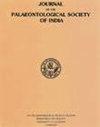Microfacies correlation, analysis and palaeoecological reconstruction of Rupelian–Aquitanian succession in the central part of Lorestan Province, Northwestern Iran
IF 0.6
4区 地球科学
Q4 PALEONTOLOGY
Journal of the Palaeontological Society of India
Pub Date : 2023-09-23
DOI:10.1177/05529360231181862
引用次数: 0
Abstract
The Oligocene–Miocene Asmari Formation is a sequence of shallow-water carbonate carbonates in the Zagros Basin. This formation is a significant oil reservoir that was formed in the Zagros foreland basin in southwestern Iran. The Razan section, located in the northwest of Zagros in the Lorestan province, was investigated to study microfacies types and evaluate the sedimentary environment. This section was then compared with the MakhmalKuh and Dehloran sections. It comprises limestone units with thin to medium strata, sometimes thick-bedded limestone, and other skeletal and non-skeletal components. Based on the biostratigraphy studies, 24 foraminifer genera and species have been identified. Among the foraminifera, the species of Peneroplis farsensis, Peneroplis evolutus, Austrotrilina howchini, Austrotrilina asmarensis, Dendritinarangi, Quinqueloculina sp., Triloculina trigonula, Pyrgo sp., Polymorphinids, Spiroluculina sp. and Meandropsina anahensis are the most important specimens. Based on identified co-occurrence taxa, the Austrotrilina howchini–Peneroplis evolutus assemblage zone has been recognised in the study area, which indicates early Miocene (Aquitanian). Texture analysis and faunal assemblages led to the recognition of fourteen microfacies. Based on the petrographic analysis, five depositional settings were determined in the studied section: (a) the outer ramp settings dominated by pelagic foraminifera, bryozoan, echinoid and benthic foraminifera such as Nummulites, Rotalia, Dendritina and Meandropesina iranica as a proxy for relatively deep marine conditions; (b) the mid ramp, characterised by sizeable perforate foraminifera such as Amphistegina, Operculina, Heterostegina and planktonic foraminifera; (c) the barrier, marginal marine environment dominated by foraminifera such as Miogypsinoides sp., Peneroplis, Meandropsina, Dendritina and Neoalveolina, as well as peloid and corallinacean algae; (d) the lagoon dominated by benthic foraminifera Austrotrillina, Dendritina, Peneroplis, Miogypsinoides, Borelis, Archaias, miliolids and red algae and (e) the tidal flat, the shallowest part of the inner ramp, dominated by fenestral dolo-mudstone without any fossils. The faunal assemblages represent warm tropical waters under euphotic and mesophotic conditions in a homoclinal ramp.伊朗西北部Lorestan省中部鲁佩里亚-阿基坦期演替微相对比、分析及古生态重建
渐新统—中新统阿斯马里组是扎格罗斯盆地的一套浅水碳酸盐岩。该组是伊朗西南部扎格罗斯前陆盆地形成的重要油藏。在Lorestan省Zagros西北部的Razan剖面进行了微相类型研究和沉积环境评价。然后将这部分与MakhmalKuh和Dehloran部分进行比较。它包括具有薄到中等地层的石灰岩单元,有时是厚层石灰岩,以及其他骨架和非骨架成分。通过生物地层学研究,鉴定出有孔虫属和种24种。在有孔虫中,farsenis Peneroplis evolutus、Austrotrilina howchini、Austrotrilina asmarensis、Dendritinarangi、Quinqueloculina sp.、trigonula、Pyrgo sp.、Polymorphinids、Spiroluculina sp.和meandropensis是最重要的标本。根据已鉴定的共生类群,在研究区确定了Austrotrilina howchini-Peneroplis evolutus组合带,属于早中新世(阿基塔尼亚期)。结构分析和动物组合鉴定出14个微相。根据岩石学分析,确定了研究剖面的5种沉积环境:(a)外斜坡沉积环境以Nummulites、Rotalia、Dendritina和Meandropesina iranica等上层有孔虫、苔藓虫、针孔虫和底栖有孔虫为主,代表了相对较深的海洋环境;(b)中部斜坡,以大型有孔有孔虫为特征,如Amphistegina、Operculina、Heterostegina和浮游有孔虫;(c)以miogypsinides sp.、Peneroplis、Meandropsina、Dendritina和Neoalveolina等有孔虫以及球藻和珊瑚藻为主的屏障边缘海洋环境;(d)泻湖以底栖有孔虫austrortrillina、Dendritina、Peneroplis、miogypsinides、Borelis、archaeas、milolids和红藻为主;(e)内坡道最浅处潮滩以无化石的门侧白云岩为主。动物群组合代表了温暖的热带水域在同斜坡的中光和中光条件下。
本文章由计算机程序翻译,如有差异,请以英文原文为准。
求助全文
约1分钟内获得全文
求助全文
来源期刊

Journal of the Palaeontological Society of India
PALEONTOLOGY-
CiteScore
1.10
自引率
16.70%
发文量
0
期刊介绍:
The journal is devoted to the publication of original papers and review articles dealing with all aspects of Paleontology, Paleobotany, Stratigraphy, Geochronology, Anthropology and Pre-history.
 求助内容:
求助内容: 应助结果提醒方式:
应助结果提醒方式:


